Monday, April 30, 2007
Fly Me To The Moon
Meanwhile, here's a new video from NASA intended to get people talking about returning to the Moon:
You probably heard something about this a few months back: NASA is making plans to establish a permanent manned (peopled?) lunar base, probably at the Moon's south pole, somewhen around 2020. There's a nice summary of the plan and links to other resources here.
What impresses me most about this video is its coolness. NASA ought to be about inspiring new generations of up-and-coming taxpayers to explore the final frontier, yet all too often their public face is as dry and uninspiring as an actuarial convention (no offense to actuaries).** C'mon, people! These are real scientists, engineers, pilots and explorers seeing and doing things that no one has ever seen or done before! Making it exciting should be the easy part. This little film might be criticized for looking too much like a video game or movie trailer, but its the first sign of life I've seen out of NASA in a long time so I like it.
My personal position on building a Moon base: Hell yes, where do I volunteer? Although I hit the tail end of the Baby Boom, I consider myself a Space Age kid more than a Boomer. But I also grew up, and I think if NASA and the United States commit to returning to the Moon we need to have an honest, grown-up discussion about why we're doing it. And the fact is, there is almost no scientific justification for sending people to live on the Moon, and even less economic justification. Anything humans could study or mine from the lunar surface could be accomplished cheaper and safer in near-Earth orbit or by robots. We built a space station on the promises of the scientific breakthroughs and amazing commercial opportunities it would deliver, but it hasn't yielded a single paper in the scientific literature or an industrial process or product anyone wants to buy. We won't fall for the same argument again. As far as I'm concerned, the only real reason for returning to the Moon is to live there: colonization. Expand our one-planet species to two.
Is that reason enough? It is for me: I think humanity's growth into the galaxy is inevitable and I'd like to live to see it. In fact, give me a fast Internet uplink and I could do about 98% of my job on the Moon as well as I do it here (though I'm sure the 1.3-second time delay due to the pesky limit imposed by the speed of light would be frustrating--almost like being back on dial-up). The ultimate telecommute.
Is it reason enough for everyone else? I dunno ... but I'm pretty sure that's where the debate should be: not about advancing science or exploiting new resources, arguments the pro-returners would lose on their merits. The question is, are we ready to grow up, move out of the spacious and comfortable family home, and set ourselves up in a grungy little studio apartment across town? I say we are, but I think I'm in a small minority.
.
.
**Speaking of interesting lines of work, a couple of weeks ago my wife and I stayed at a hotel hosting the International Canned Fruit Conference. The lobby and elevators were full of business-suited conferees wearing badges from nations around the world, all of them evidently deadly serious about their canned fruit. I could only wonder what recent amazing advances have been made in the science of fruit canning to justify the time and expense of gathering people from Peru, Greece and Russia to learn about them. You'd think that'd be something you could handle with a brief newsletter, plus maybe a phone call for the really big breakthroughs. But apparently not. Who knew?
Sunday, April 22, 2007
Jim Borgman
For an hour, Mr. Borgman entertained an audience of about 200 with stories about how he and Mr. Scott created "Zits" almost accidentally during a mutual visit to Sedona, Arizona. He talked about cartooning, family, and the creative process, and was a terrific speaker. He also struck me as being more sensitive and even sentimental than I'd expected a hard-bitten award-winning editorial cartoonist to be. He choked up talking about letters he gets from readers describing how much "Zits" has helped them understand and communicate across generations, or even from parents whose children have died and who read "Zits" as a way to keep up with the lives their kids might have had. Unexpectedly moving, and a good reminder of the subtle power of this medium.
Although the audience seemed most impressed by the stories he told or the sketches he drew, what I took away from his talk was awe for his tremendous work ethic. As Mr. Borgman described it, he works on "Zits" about three days a week, does editorial cartoons three more days a week, and saves the seventh day for whatever he didn't get done the other six. In other words, he works constantly and hard to maintain a high-octane level of quality and professionalism--which made me more acutely aware than ever of my own wasted time. Hard Work = Success: who knew? I resolved to do better.
I had a chance to tell him that after waiting in a looooong line for him to sign a book for us. My wife and I were nearly literally the end of the line; the venue had sold out of his books before we could buy one, so after his talk we actually drove to a nearby bookstore, bought a "Zits" collection, and drove back to the signing. I've done a few talks and signings myself--though nothing remotely so large--and was incredibly impressed with the fortitude Mr. Borgman displayed in chatting charmingly and drawing sketches, staying more than a hour past his scheduled time to make sure everyone was served. Meanwhile, his wife worked the line with her own conversational charms and made sure everyone signed a card for Jerry Scott that Borgman had drawn. They made a good team.
We reached his table, chatted for a moment, and he asked if we had a favorite character we wanted him to draw in our book. I in turn asked if there was a character he wanted to draw--maybe one that no one ever asks for and he wasn't yet sick of. He replied that no one ever asks for Connie and Walt, the Mom and Dad in "Zits." We said that would be perfect, since we pretty much are the Mom and Dad in "Zits." So he autographed our book and drew this:
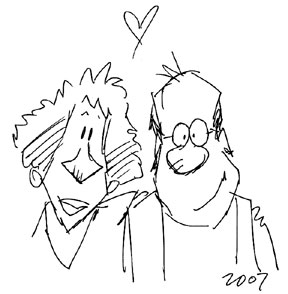
That there's Grade-A cartooning by a man who earned every success he's enjoying today. It was a pleasure to see and meet him.
Thursday, April 19, 2007
2007 Eisner Award Nonimations
Best Reality-Based Work
Fun Home by Alison Bechdel
I Love Led Zeppelin by Ellen Forney
Project X Challengers: Cup Noodle by Tadashi Katoh
Stagger Lee by Derek McCulloch and Shepherd Hendrix
Best Graphic Album—Reprint
Absolute DC: The New Frontier by Darwyn Cooke
Castle Waiting by Linda Medley
Shadowland by Kim Deitch
Truth Serum by Jon Adams
Surprising? Exciting? Intimidating? Yeah. I had to double-check it a few times myself, and even now I'm not sure I trust my own lying eyes. Two Eisner nominations is a tremendous honor.
Maybe after the voting ends I'll have some comments about who I think should win and who will win (hint: not necessarily me). Until then, I think it's fairest to let the works speak for themselves. However, if any Eisner voters happen to read this, I'm an amoral man with cash to spend. I'm just sayin'.
Mom's Cancer began on the Web and won the Eisner for "Best Digital Comic" in 2005. The nominations announced today are for the subsequent book, which I'll defend as its own unique thing. Although most of the words and pictures are the same, reading the story collected in print rather than serialized over several months online is a very different experience. In addition, a book is much more collaborative. While the online version was all me, the book reflects tremendous creative contributions by people at Abrams, including my book's editor, art director, designer, and production manager. They added ideas I wouldn't have conceived myself and went to unusual expense and effort to publish a quality book. This one's for the team.
And since I'm cheerleading for the team, I'll add that Abrams got two other Eisner nominations this year, which is terrific for a relatively small publishing house that wasn't even in the comics/graphic novel game a few years ago. They are Art Out of Time: Unknown Comics Visionaries, 1900-1969 by Dan Nadel (nominated for "Best Archival Collection"), and Cartoon America: Comic Art in the Library of Congress edited by Harry Katz (nominated for "Best Comics-Related Book"). I have both books and think they're great.
More soon, I'm sure. And "Woohoo!"
.
Tuesday, April 17, 2007
Mentors
I gave that talk yesterday. My wife came along as did my two girls who, as I also mentioned before, are now students at my former university. As we rounded a corner toward the classroom, I saw awaiting me in the hall approximately 20 physics students, my host, and a man I hardly dared hope would be there: Dr. E. (Since I didn't ask his permission to write about him, I'll keep him anonymous.)
I've been lucky to have two people in my life I considered mentors, one in high school and Dr. E. in college. Both took an interest in young me and who I was, what I was doing, what my plans were, how I was developing. Both went to some effort--how much I only appreciated in retrospect--to try to make good things happen for me. I met Dr. E. my freshman year when, as I recall, he solicited my astronomy class for anyone interested in doing a one-unit independent study project at the small campus observatory with him. I tackled him after class and spent the next four years dogging his heels.
I graduated in 1983. I'd only touched base with Dr. E. two or three times since and would've been pleased if, out of the thousands of students who've passed through his tutelage, he remembered me at all. But of course he did, and when he saw my name on the seminar schedule he made a point to come. He's a professor emeritus now, long retired, still maintaining a campus office he visits a few times a week but gradually pulling away from academia in favor of travel, political activism, and family. I re-introduced him to my wife, whom he'd met many times when she and I were not-yet-betrothed students, as well as to my children he'd never met, and I felt like Kevin Costner presenting his family to his father at the end of "Field of Dreams." I would hardly have been more dumbstruck if Dr. E. had walked out of a magic cornfield and asked if I wanted to play catch. Not only did he remember me, but he brought along a caricature of himself I drew and posted on the astronomy club bulletin board 25 years ago and never knew what became of until it showed up framed in his hands yesterday.
Here's the thing with me and physics: I wasn't a natural at it. I was smart, but I wasn't one of those students for whom it came easily, whose brains seem to have little vacancies exactly the right size and shape for a wave equation or uncertainty principle to slip into. I knew those students and they're scary. As I said at the seminar, I stuck with physics because once a quarter I could count on having a single "A-ha!" moment when the clouds parted, trumpets sounded, angels sang, and for an hour I felt like I'd glimpsed something fundamental and beautiful and true about the universe. The other thousand hours a year were a tough slog I endured so I could experience those rare highs I never got anywhere else.
So I managed to graduate but always regretted not working a bit harder, not grasping or remembering a bit more than I did. I didn't master physics, I survived it. Nevertheless, I think it has informed everything I've since done in journalism, environmental chemistry, writing--even cartooning. In some ways, physics was the best philosophy course I ever took, and I tried to tell the physics students yesterday that even if you don't work in science, it can enrich whatever you do. Conversely, if you do end up working in science, bringing your non-scientific interests and passions to the job will enrich it as well.
Talking with Dr. E. afterward, he allowed that he'd had many students brighter than me. He would've been disingenuous to say otherwise and I would've been foolish to argue. But he added that I'd always struck him as someone more interested in studying than testing--more into process than result--in a way he found refreshingly rare in an overly goal-centered environment. He may have used the word "special," to which my wife may have replied, "Uh huh." I didn't go on to research or grad school, never became a real physicist, but I managed to integrate my education into my interests and life in a way a lot of graduates didn't. I made my own path--almost entirely accidentally, to be sure, but with interesting and rewarding results. I built a great family and a career I enjoy. More than academic postings and papers published, those were the kinds of outcomes Dr. E. wished for his students.
He told me I was a success.
On the remote chance Dr. E. finds this post, I won't embarrass him by trying to capture what that meant to me. But holy moley! A lot.
Today's lesson: if you've ever had a mentor in your life and you have an opportunity to tell them how much you appreciate what they did for you, take it. I've had that chance with both my mentors now, and it'll do you both a world of good. Second, if you ever have a chance to be a mentor, do it. I don't think it really takes much to give a kid some encouragement that could change his or her life--in fact, when I talked to my other mentor years later, he seemed a little puzzled that he'd had such an impact on me. I think it's a matter of simple physics; a little push at one end of a long, long lever can be magnified into a mighty force at the other end.
Oh, and yesterday was my birthday. It was a great day.
.
Wednesday, April 11, 2007
Jugendliteraturpreis
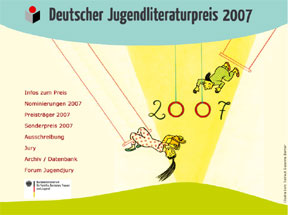
Tuesday, April 10, 2007
Guerre aux Maux
 .
.Monday, April 09, 2007
Interview: Consumer Health Interactive
The story features Mom's Cancer, my friend Miriam Engelberg's Cancer Made Me a Shallower Person, and Marisa Acocella Marchetto's Cancer Vixen. It also provides a nice survey of what I'd call the adult graphic novel arena, touching on Art Spiegelman, Marjane Satrapi, Dan Clowes, and Harvey Pekar. Psyche interviewed academics and business people well versed in graphic novels and did more research than anyone who's ever written about me and/or my book, I think. I really enjoyed our interview and just wish more of our discussion could've been included. My only insignificantly tiny complaint is the subtitle (which Psyche probably didn't write anyway) that reads, "Whap! Pow! Bam! They're no caped crusaders...." The "Holy Moley! Comics Aren't Just for Kids!" headline exceeded its freshness date several years ago.
One paragraph I liked:
Graphic novels about health issues won't replace medical books and hospital brochures. They won't help readers decide on a course of cancer treatment or whether to seek psychotherapy. But they may offer invaluable support and solace for readers who want a breather from the grueling ordeal of treatment.
That sounds about right to me. I'd add that, in addition to support and solace, books like mine can provide useful, first-hand, honest information that readers won't find anywhere else. I don't explain carcinogenesis or oncogenes, but I did try to depict the everyday impact they have on real life--stuff you don't find in the textbooks and brochures. One of the main reasons I wrote Mom's Cancer was because I didn't find anything like it when it would've done me some good.
My thanks to Psyche and Yourhealthconnection.com, which is a division of prescription plan provider Caremark.
Wednesday, April 04, 2007
A Walt Kelly Appreciation
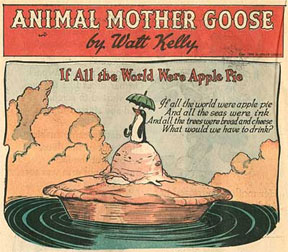 A pre-Pogo piece that was new to me
A pre-Pogo piece that was new to me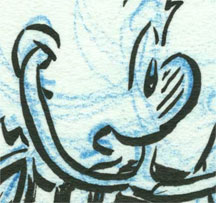
Monday, April 02, 2007
Animation
The transparent plastic sheets that the crews work with in the film are called cels (for "celluloid"). Like so much else in the history of both animation and comics, the materials actually used to produce the finished products got very little respect. To the creators, they were a means to an end, often considered disposable. Some animation studios scraped the paint off of cels to reuse them; others piled them in big heaps and burned them. In addition, the paints weren't intended to last and often flaked off over time, adding to the scarcity of cels that managed to survive.
.
For a while, the Disney Studios sold cels to tourists at Disneyland for a few bucks each. When I finally figure out how a flux capacitor works and build my time machine, that's one of the first place-times I intend to visit. In the last 20 or 30 years, of course, the value of original animation art has been recognized and, in some cases, inflated beyond reason. Today an early Disney cel in decent condition with a famous character could sell for several tens of thousands of dollars or more.
.
As I wrote about original comic art a while back, original animation art is something I could easily become obsessed with. Too easily. Fortunately I have some self-control, and have so far limited myself to three pieces, ranging from ridiculously modern to almost as ancient as you can get.
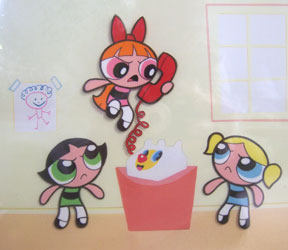
This is three-cel set-up from the PowerPuff Girls cartoon. The two girls on the sides (Buttercup and Bubbles) are on one cel, the center girl (Blossom) is on another, and Blossom's mouth is on a third, all stacked atop one another. The mouth gets its own cel so the animators can draw Blossom talking without redrawing the entire figure each time. My girls and I were fans of the PowerPuff Girls, which I thought was occasionally one of the smartest, funniest cartoons around. I bought this as kind of a gift for us all.
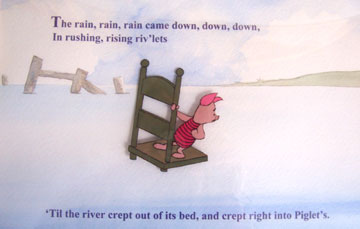
Above is a two-cel set-up of Piglet from the 1968 movie "Winnie the Pooh and the Blustery Day," which won an Academy Award for "Best Cartoon Short Subject." Piglet is on one cel and his chair is on another. Since they came without a background, I painted a watercolor landscape to go behind them and printed the lyrics on the painting. I was drawn to this piece for perhaps the most common reason people collect stuff like this: I remembered loving this movie from my childhood and wanted a piece of it. It was Disney. And it was Piglet, who's been a favorite character around our house. I lied and told my family I got it for them; it was really for me.
One of the fun parts of getting an animation cel is watching the movie and freeze-framing it to find exactly where your cel was used. My Piglet actually has little dimples in the pink paint on his arm and foot that I assumed were age-related damage until I saw the exact same dimples on-screen. The flaws are impossible to see blazing past at 24 frames per second, but they were there in the original. I thought that was pretty cool.
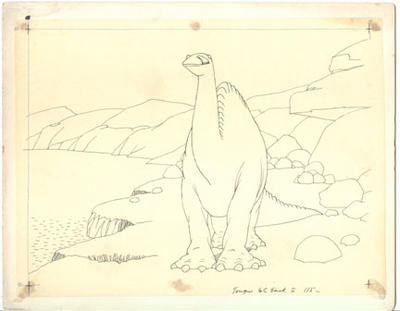
I've written about this piece--not really a cel because it was drawn on rice paper before animators began using transparent celluloid--and what it means to me before. This is a frame from "Gertie the Dinosaur" by Winsor McCay done in 1914, many years before Disney made "Steamboat Willie." McCay was a giant in both cartooning and animation, and buying a piece of his work was a long-time ambition of mine and the first thing I did with the "cartooning money" I earned as an advance on Mom's Cancer. When my house catches fire, this is the one thing I plan to grab on my way out the door. After the people and animals are safe. Of course.
That's my entire animation collection. As long as my will is strong and my kids remain in school, that'll be it for a while. I can see how people could go crazy with this hobby, though. Collecting favorite films, themes, artists, owning a unique piece of movie or television history. It's probably just as well I don't have all the money in the world.
